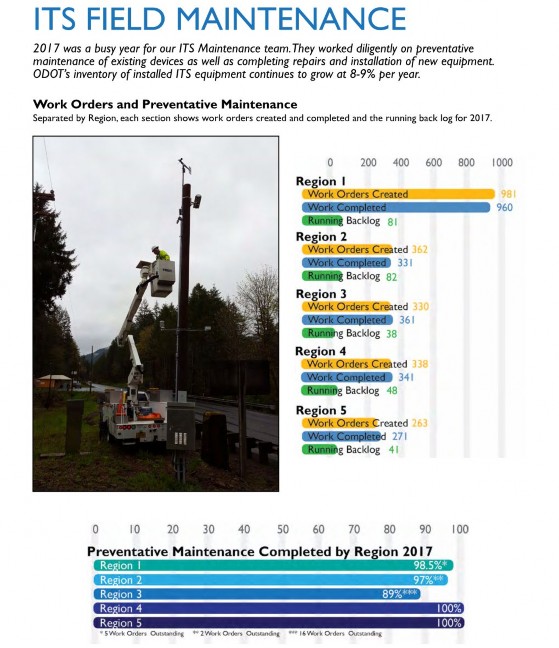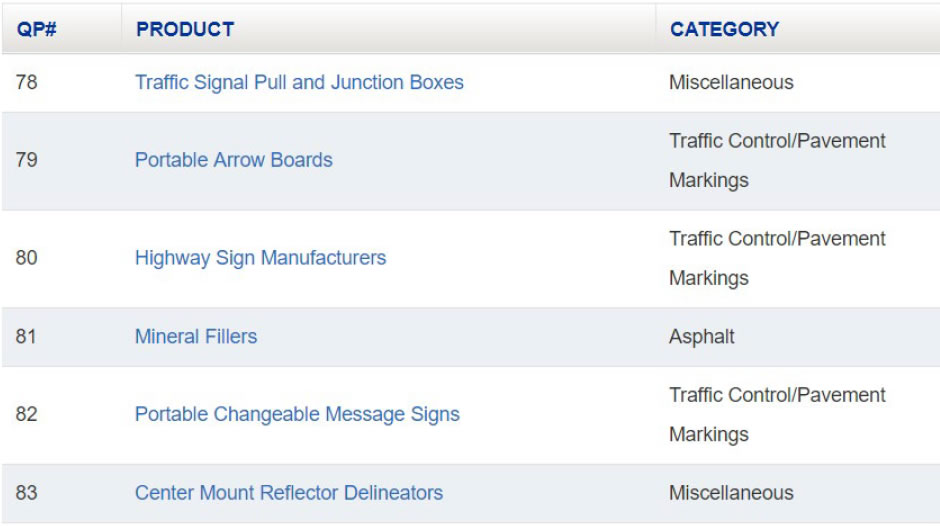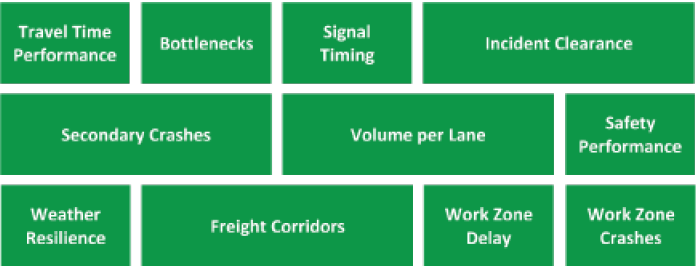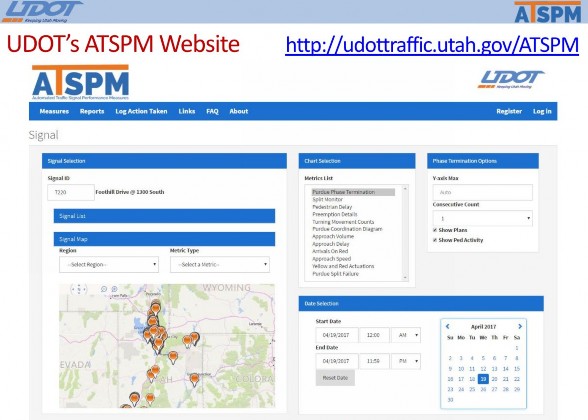Organizing for TSMO
Case Study 2: Systems and Technology – Utilizing ITS Architecture to Advance TSMO
Chapter 2 - Best Practice Examples
The Oregon Department of Transportation (ODOT), Georgia Department of Transportation (GDOT), Ohio Department of Transportation (OhioDOT), and the Utah Department of Transportation (UDOT) participated in previous second Strategic Highway Research Program (SHRP2) efforts. The capability maturity model (CMM) workshops with SHRP2 helped inform them about transportation systems management and operations (TSMO) and how it can apply to their agencies. This chapter highlights several successful initiatives each agency accomplished, specifically regarding systems and technology for TSMO.
Oregon Department of Transportation (ODOT)
ODOT supports the transportation needs of the State of Oregon through five regional offices. ODOT manages almost 74,000 miles of highways, streets, and roads, and over 8,000 bridges.
Enhancing Successful Technology Utilization and Deployment
Over the past few years, ODOT has developed a strong relationship with their internal information systems group, which has a proven systems engineering methodology. The information systems group is responsible for providing application development services, computer support, information security, governance, planning, and other information technology services. This relationship has established a strong foundation to implement ODOT's systems and technology programs, especially when TSMO was introduced. When completing the CMM assessment as part of the SHRP2 efforts, ODOT found that systems and technology was one of their strongest areas.
The agency has a statewide approach for operating and maintaining systems and technology. As such, ODOT needs a trained workforce to deploy their systems and software across the State for a broad range of uses that require tailoring the systems and software for urban and rural areas where needs vary. ODOT's intelligent transportation systems (ITS) maintenance group is responsible for ensuring ITS and signal devices are operational. This group is critical to success once projects and programs have been deployed or implemented. Figure 4 shows the workload of the ITS maintenance group.
 Figure 4. Photo. Intelligent Transportation Systems Field Maintenance
Source: 2017 Operations Program Annual Report, ODOT, 2017
Figure 4. Photo. Intelligent Transportation Systems Field Maintenance
Source: 2017 Operations Program Annual Report, ODOT, 2017
ODOT attributes their success in systems and technology to the realization that ITS is a multidiscipline area. As such, their staffing includes a combination of information technology professionals, civil engineers, and electrical engineers. This mix of staff has proven to be effective at solving issues involving systems and technology, especially regarding software.
Planning and ITS
One of the goals identified after completion of the CMM assessment was to embed the ITS architecture and planning efforts within broader regional planning efforts. ODOT has a statewide ITS plan and statewide ITS architecture. ODOT has also worked with regional partners to develop regional ITS plans and regional ITS architectures but these plans have been disconnected from other regional planning efforts. As a result of the CMM assessment, ODOT is working to better integrate regional ITS and operations planning with the Region Transportation Plan update process.
ODOT has integrated systems engineering into its typical project delivery process. Systems engineering tasks have been integrated into their project schedule templates for operations projects. Project leaders now have a reminder to plan and think through systems engineering tasks in the early stages of a project so needs are preemptively identified and accounted for. Systems engineering deliverables, such as a concept of operations document, are prepared prior to the design acceptance stage in the project development process. This is the point early in the project where the full scope of the project is set. Having the desired system functions clearly specified early in the project ensures a good scope for the design and construction of the project and allows any required software development to proceed in parallel. This approach allows efficient delivery of projects, ensures that desired project outcomes are clearly understood, and provides good system documentation. ODOT noted that starting discussions about systems engineering early in a project has greatly impacted their ability to integrate the process into project development and delivery.
Another reason for ODOT's success is the process they established for scaling the systems engineering process to each project. For redundant projects, this process is minimal, but for a new project with new concepts, this process is a more in-depth effort. The purpose is to define new concepts and assess needs before the project begins. ODOT has a systems engineering and ITS architecture compliance checklist to efficiently identify which systems engineering tasks are needed for a project. An excerpt of this checklist is shown in Figure 5.
 Items are: Archived Data Management, Public Transportation, Traveler Information, Traffic Management, Vehicle Safety, Commercial Vehicle Operations, Emergency Management, Maintenance and Construction Management
Figure 5: Chart. Systems Engineering and Architecture Compliance Checklist
Source: ODOT
Items are: Archived Data Management, Public Transportation, Traveler Information, Traffic Management, Vehicle Safety, Commercial Vehicle Operations, Emergency Management, Maintenance and Construction Management
Figure 5: Chart. Systems Engineering and Architecture Compliance Checklist
Source: ODOT
Georgia Department of Transportation (GDOT)
GDOT supports the transportation needs of the State of Georgia through seven districts. GDOT manages over 18,000 miles of interstates and highways, 5,000 miles of railroad track, 454 airports and heliports, and two marine ports.
Qualified Product List
After completing the CMM assessment as part of the SHRP2 efforts, GDOT created a Qualified Product List (QPL) containing all the ITS equipment approved for deployment on GDOT ITS projects. Vendors and manufacturers have their equipment tested and approved by GDOT for listing on the QPL. Contractors can pick any vendor or manufacturer for ITS equipment included on the QPL. Figure 6 shows part of the QPL for traffic signal and ITS equipment.
 A table with 3 columns: QP#, Product, Category. Row 1 - 78, Traffic Signal Pull and Junction Boxes, Miscellaneous; Row 2 - 79, Portable Arrow Boards, Traffic Control/Pavement Markings; Row 3 - 80, Highway Sign Manufacturers, Traffic Control/Pavement Markings; Row 4 - 81, Mineral Fillers, Asphalt; Row 5 - 82, Portable Changeable Message Signs, Traffic Control/Pavement Markings; Row 6 - 83, Center Mount Reflector Delineators, Miscellaneous
Figure 6. Chart. Example QPL Products and Categories
Source: http://www.dot.ga.gov/PS/Materials/QPL
A table with 3 columns: QP#, Product, Category. Row 1 - 78, Traffic Signal Pull and Junction Boxes, Miscellaneous; Row 2 - 79, Portable Arrow Boards, Traffic Control/Pavement Markings; Row 3 - 80, Highway Sign Manufacturers, Traffic Control/Pavement Markings; Row 4 - 81, Mineral Fillers, Asphalt; Row 5 - 82, Portable Changeable Message Signs, Traffic Control/Pavement Markings; Row 6 - 83, Center Mount Reflector Delineators, Miscellaneous
Figure 6. Chart. Example QPL Products and Categories
Source: http://www.dot.ga.gov/PS/Materials/QPL
Prior to the QPL, contractors for a project would submit products after reading the project specifications. GDOT would then have to review each product on a case-by-case basis to determine if it should be approved or denied for the project. This process delayed project construction and did not provide GDOT with sufficient time to review product compliance with specifications. GDOT's considerable number of simultaneous projects increased this challenge because the number of reviews became difficult to manage. The QPL eliminated this issue by significantly decreasing the amount of time the agency spends on product reviews.
One of the challenges associated with the QPL is keeping the list up to date. ITS technology is rapidly changing and improving and new products are released often. Part of the difficulty lies in trying to determine if a product requires retesting due to updates. This can become overwhelming if manufacturers release many updated products at once but fail to inform GDOT. This requires GDOT to actively monitor which products are no longer manufactured. Another issue is when specifications are updated, there is a possibility that products no longer meet the new specification and must be retested.
Vendors and manufacturers realize the value of the QPL and will meet with GDOT to review specifications and share feedback. Making the process collaborative is mutually beneficial.
Ohio Department of Transportation (OhioDOT)
OhioDOT supports the transportation needs of the State of Ohio through 12 regional districts. OhioDOT manages over 49,000 lane-miles of interstates, highways, arterials, and collectors. Development of OhioDOT's TSMO program began in 2013 and is supported by the Traffic Management group of the Division of Operations.
ITS Maintenance and Operations
Historically, OhioDOT has centrally maintained ITS field devices with the exception of network routing and switching, which had been managed by the State Office of Information Technology (OIT). Through completion of CMM assessments as part of the SHRP2 efforts, one of the goals that OhioDOT established involved moving ITS network routing and switching from OIT to TSMO. This was beneficial for both groups. Operation and maintenance of ITS devices, including signals, did not align well with OIT's primary responsibilities. Following this shift, OhioDOT has seen improvements in service and reliability. Having an ITS network separate from the statewide information technology network provides an advantage because it is easier to manage and maintain. In addition, having all maintenance-related staff in the same group makes coordination and communication easier.
OIT is still involved with OhioDOT for information technology needs including data storage, management, and security. This is performed in cooperation with OhioDOT's TSMO unit through regular meetings.
OhioDOT experimented with allowing staff to utilize other non-engineering technical skills. By exploring other skills, employees can prove to OhioDOT that they are capable of handling different responsibilities and potentially finding a new role within the organization. An example of this was when an OhioDOT electrical engineer transitioned into an infrastructure specialist role while still performing electrical engineering tasks. This staff member is now the lead network engineer for the ITS network. Having flexible and capable staff has been instrumental to their TSMO successes.
Performance Measures in Planning
Additionally, OhioDOT has developed the Traffic Operations Assessment Systems Tool (TOAST) to help inform project planning by using available transportation data. Scores are calculated for routes with breaks at urban boundaries, interchange center points, and changes in roadway functional class. Scoring values range from 0-10 and performance percentages are calculated. Routes with lower percentages are identified as candidates to benefit from TSMO strategies. The data categories for OhioDOT's TOAST system are shown in Figure 7.
 Categories: Travel Time Performance, Bottlenecks, Signal Timing, Incident Clearance, Secondary Crashes, Volume per Lane, Safety Performance, Weather Resilience, Freight Corridors, Work Zone Delay, and Work Zone Crashes
Figure 7: Chart. TOAST Data Categories
Source: FHWA
Categories: Travel Time Performance, Bottlenecks, Signal Timing, Incident Clearance, Secondary Crashes, Volume per Lane, Safety Performance, Weather Resilience, Freight Corridors, Work Zone Delay, and Work Zone Crashes
Figure 7: Chart. TOAST Data Categories
Source: FHWA
Having a clear strategic plan for systems engineering and ITS architecture for OhioDOT has enabled the agency to mature their capabilities in the systems and technology dimension. Communicating this ITS plan and engaging with the statewide audience ensures that the correct priorities are set and that the plan is successfully implemented.
Utah Department of Transportation (UDOT)
UDOT supports the transportation needs of the State of Utah through four regional offices. UDOT manages over 6,000 miles of interstates and State highways.
Modern Traffic Signal System
After completing the CMM assessment as part of SHRP2 efforts, UDOT prioritized signal upgrades in the State to support automated traffic signal performance measures (ATSPM) software that was developed in an effort led by the Indiana DOT with participation from FHWA, 11 State DOTs, and the City of Chicago. The ATSPM software allows better management and operation of the traffic signal system through visualization of high-resolution controller data. The software is open source and UDOT added more performance measures and customized the user interface in a way that fit their needs. The software has been shared with other agencies across the United States.
Over 1,900 traffic signals were upgraded in Utah allowing UDOT to monitor and analyze the data of all signals in real-time, regardless of the owner, to make better and faster decisions. These decisions include responding to maintenance and operational issues as well as determining traffic trends. Because of these signal network upgrades, UDOT can monitor traffic across the State 24-hours a day, 365 days a year. In addition, UDOT created a website for the public to access traffic signal data, shown in Figure 8.
 Figure 8. Photo. UDOT's ATSPM Website
Source: UDOT Automated Traffic Signal Performance Measures, UDOT, 2017
Figure 8. Photo. UDOT's ATSPM Website
Source: UDOT Automated Traffic Signal Performance Measures, UDOT, 2017
An enabling technology used by the signal system is a fiber optic network that connects all signals to UDOT. In the late 1990s during a major construction project near Salt Lake City, a decision was made to start laying fiber optic cable for the transportation system interconnect. Since this decision, installing either fiber optic cable or fiber optic conduit has become standard practice for large UDOT construction projects. Shortly after, UDOT hired a fiber manager who began to build public private partnerships (PPP) with private telecommunications companies. Through these PPPs, UDOT shared the costs of laying fiber and conduit with the companies based on an agreed upon trade value. This significantly reduced the cost of fiber construction for UDOT. These efforts contributed to growing the fiber optic network to over 2,000 miles in length, less than half of which were directly paid for by UDOT. Another key success to Utah's development is inclusion of all traffic signals on the same communication network, which enables UDOT to make important decisions on a large scale.
The traffic signal management plan is the overarching document that aligned these efforts. This plan, developed with FHWA, defines the mission statement, number of employees, budget, goals, and objectives for traffic signal operations and maintenance. In addition, the plan defined the goal of connecting all devices by fiber or radio statewide. This plan is valuable for providing a structured vision for the traffic signal program and how this program aligns with the overall goals and objectives of the agency.